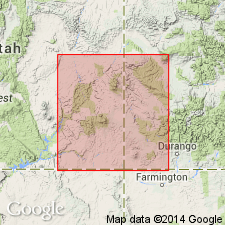
- Usage in publication:
-
- "Gothic" shale
- Modifications:
-
- Overview
- Dominant lithology:
-
- Shale
- AAPG geologic province:
-
- Paradox basin
Summary:
Is an informal name in use by the petroleum industry for a black shale unit that is part of evaporite cycle 3 in the Ismay production interval of the Middle Pennsylvanian Paradox Member of the Middle and Upper Pennsylvanian Hermosa Formation in the Paradox basin of southeast UT and southwest CO. The unit can be readily identified on gamma-ray logs throughout most of the Paradox basin. "The base and top of the Paradox Member of the Hermosa Formation is usually defined by the first and last halite beds. In the deep part of the Paradox basin, the member consists of 29 identifiable evaporite cycles (Hite, 1960), and its maximum depositional thickness was probably about 7,000 ft (2130.9 m). These cycles are bounded by disconformities and when complete the sequential order from the base upward is (a) anhydrite, (b) very silty fine grained dolomite, (c) silty calcareous black shale, (d) silty fine grained dolostone, (e) anhydrite, and (f) halite with or without potash salts. With the exception of the black shale unit, all of the elements of the cycle were deposited in response to salinity changes in the brine basin. In the deep part of the Paradox basin, the cyclical sequence consists of up to 80 percent halite. Going from basin deep to basin shelf, the amount of halite in the cycles diminishes while the percentage of dolostone and anhydrite increases."
Source: GNU records (USGS DDS-6; Denver GNULEX).
For more information, please contact Nancy Stamm, Geologic Names Committee Secretary.
Asterisk (*) indicates published by U.S. Geological Survey authors.
"No current usage" (†) implies that a name has been abandoned or has fallen into disuse. Former usage and, if known, replacement name given in parentheses ( ).
Slash (/) indicates name conflicts with nomenclatural guidelines (CSN, 1933; ACSN, 1961, 1970; NACSN, 1983, 2005, 2021). May be explained within brackets ([ ]).

